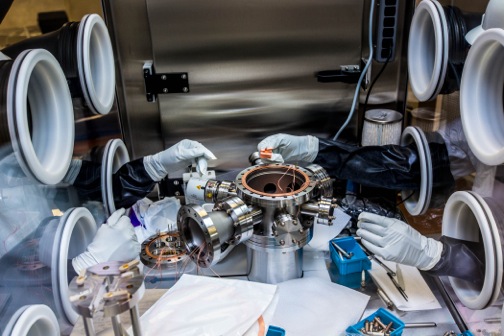
摘要
Neutrino oscillations confirmed that neutrinos are massive particles. The absolute mass scale of a neutrino, however, is not known. The critical question of whether or not the neutrino is its own anti-particle, also remains unanswered.
Studies of neutrinoless double beta decay (0νββ ) could address the above issues and determine the absolute mass scale of a neutrino. The 0νββ half-life of a nucleus is directly related to the neutrino mass. However, due to the very low mass of the neutrino, this half-life s very long, greater than 1025 years. As a result, minimizing background becomes essential in experiments searching for neutrinoless double beta decays.
The MAJORANA DEMONSTRATOR will search for 0νββ in 76Ge. This experiment will have a half-life reach beyond 1026 years and is a first step toward a large experiment sensitive to neutrino masses below 50 meV. This presentation will give an overview of the MAJORANA DEMONSTRATOR Project and describe its current construction status at the Sanford Underground Research Facility in Lead, South Dakota.

报告人简介
Chang-Hong received her B.S. in nuclear physics from Peking University (北京大学) in 1984. Shortly after that, she went to The Niels Bohr Institute in Copenhagen to study experimental nuclear physics under a government scholarship. Focusing on high-spin spectroscopy and under the supervisions of Drs. Jerry Garrett and Gudrun Hagemann, Chang-Hong received her Ph.D in physics from the Niels Bohr Institute in 1989.
After receiving her Ph. D, Chang-Hong worked as a post-doctoral research associate at the University of Tennessee in Knoxville from 1989-1992. During this time, Chang-Hong worked with Prof. Lee Riedinger at the Univ. of Tennessee and the nuclear structure group in Oak Ridge National Laboratory, and focused on experimental studies of nuclear deformation at high-angular momentum by measuring lifetimes of high-spin decays of deformed nuclei.
From 1992 to 1995, Chang-Hong was an Assistant Professor in the Dept. of Physics and Astronomy at the University of Rochester in Rochester, New York, where she continued her studies on various aspects of nuclear-structure properties at high angular momentum.
In 1995, Chang-Hong moved back to Tennessee and became a staff member in the Physics Division of Oak Ridge National Laboratory. She continued her work on studies of high-spin physics and super-deformed nuclei, and later, experiments studying properties of exotic nuclei using radioactive beams and large arrays of Ge detectors.
Chang-Hong joined the Majorana Collaboration in 2005 and gradually shifted her research interest from nuclear structure to the study of neutrino properties. She has been a Senior Scientist at Oak Ridge National Laboratory and is currently the Experimental Integration Manager of the Majorana Demonstrator project.




